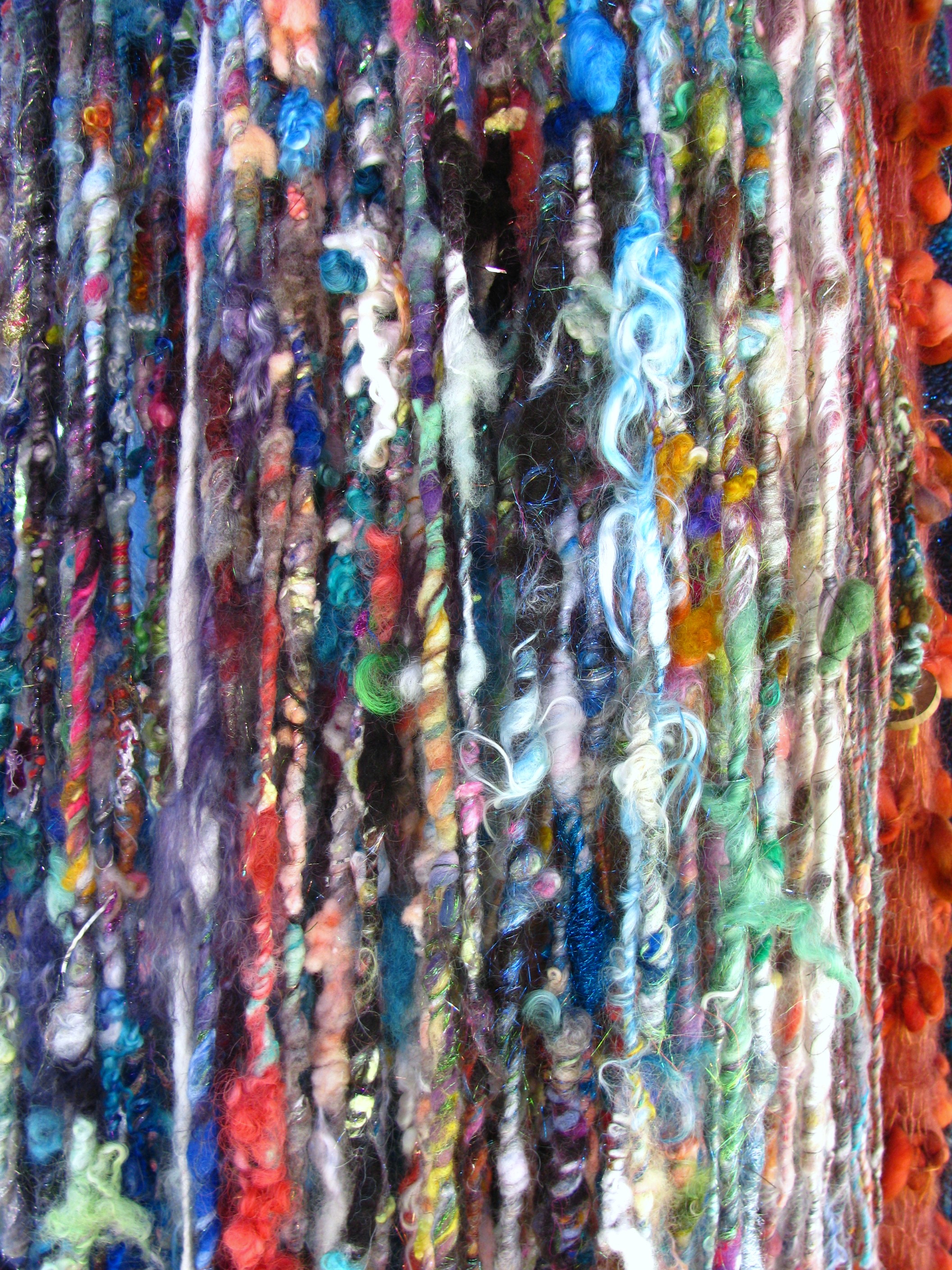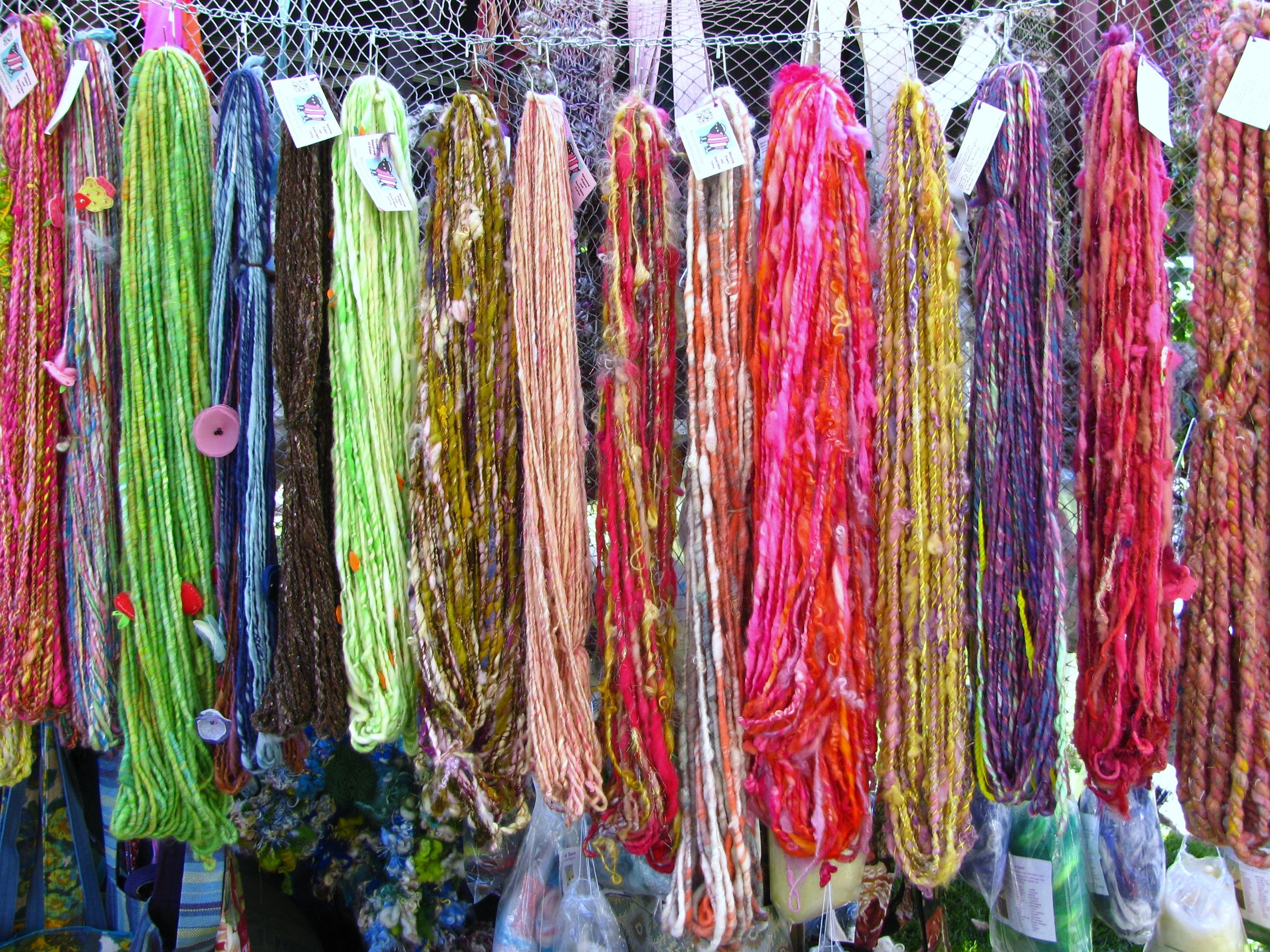Photography by Ashley Martineau // Handspun Yarns by Vendors at Yarnival 2012
Pricing handspun yarn is a difficult and often debated topic. We will approach this question from the perspective of two art yarn spinners who price their yarns to be as affordable as possible without being unfair or detrimental to the fiber art economy. We both agree that a skein of yarn is only worth what someone is willing to pay - and we have to price it using economics - rather than the following:
- We cannot put a monetary value on the worth of time.
- We cannot put a monetary value on the worth of fulfillment of creating.
- We cannot put a monetary value on the worth of creativity.
- We cannot put a monetary value on the worth of satisfaction of a customer purchasing your work.
- We cannot put a monetary value on the emotional connection we may feel with our work.
Here are some factors that are outside your control that may effect the price / market value of your yarn.
- Supply & Demand. In 2003 (pre-ETSY) the most well-known fiber artisans got $3.00/yard for their skeins. There were maybe 40 artisans selling handspun art yarn on individual websites at the peak of the market pre-ETSY. As of writing this article, there are 12,421 skeins of handspun art yarn on ETSY. More supply = less demand = reduced prices. Hello Economics.
- Your Local Market. Stuff in urban / city areas just costs more. Consider the cost of an apartment downtown compared to a house in the middle of nowhere. It's the same with the art yarn market. Chances are, if you're a brick & mortar shop in the middle of nowhere, that's going to effect your average price point and the budget of your customers. If you're a brick & mortar shop downtown - your rent is going to be higher and your yarn prices will also be higher.
- Note: this is not a factor for online shops. If you want to be a "downtown" seller online - get an amazing camera and take art-gallery worthy pictures of your yarns. The biggest factor for selling yarns online is photography.
- Agriculture. The cost of feed for sheep has skyrocketed 30% and more, and the price of wool is going up. But that doesn't mean that we just can raise the prices on our yarns 30%. Unfortunately, when it costs more to raise wool it's going to cost more to spin yarn. This is a cut everyone has to take - from the farmer to the spinner to the maker.
Price per Ounce // Price per Yard
The following guide is what we have observed in our combined 20 years of handspun art yarn spinning & sales experience, a combination of experience both selling online, and brick & mortar. We ask that you simply take our observations, compare them to your pricing, see what feels right to you, and keep in mind what your local market will bear. This is not an authoritative guide whatsoever. It's just our observation.
Price per Ounce: Many artists use price per ounce vs. yards of yarn spun as their base pricing model. This is a good formula if you have a ‘simple’ yarn- a fairly thin single ply or uncomplicated two ply from a dyed roving or blended batt. Some artists then weigh the finished yarn, and have a predetermined price for the fiber used. For example, a 4 oz braid of roving might be priced from $5-$9 per ounce, depending on fiber. This single-ply yarn might then be priced between $20-36. This is a nice price point, and in my experience, customers will happily pay this price. Yarn priced around $40.00 is a nice ‘sweet spot’ for selling.
Price per Yard: Many artists price their handspun yarn between $.50-2.00 per yard based on the price of fibers used to spin it. For example, if you have a 50 yard skein of handspun yarn, it would then be priced between $25.00-100.00. This formula takes into account not only your materials but your time, which is hard to determine and many spinners want to feel is included in their price. It is straightforward and to the point.
Averaging Time + Cost // Fair Market Value
Pricing Method: Time + Cost
If I make a funky textured yarn (plying a single that I spun from a textured batt) I price as follows:
I weigh my yarn - usually 4 ounces. To price, I take into consideration the fibers in the batt. If I have washed, dyed and have put a lot of my time into the fibers, plus have added in things like silk, sparkle and locks, my price per ounce is around $8.00. This yarn has a base price then of $32.00.
I also take into consideration my time - as difficulty in the preparation of the yarn. If I add twists or texture into the yarn, I also look at the yardage. In this example, I have 50 yds of a time consuming plied yarn. Is this yarn worth $1.00 per yard? Yes, absolutely! That sets the price at $50.00
However:
- I also know that it may not sell easily at the $1.00 / yard.
- I need to sell the yarns I make at my store to make room for more.
- My compromise? It was priced at $40.00, splitting the difference to what my market will bear between $32.00-$50.00.
PRICING METHOD: FAIR MARKET VALUE
First, I am a production spinner. I spin fast. It is not unusual for me to spin an entire fleece in a day. My favorite bobbin holds up to 4 pounds, and I fill it up multiple times a week in my peak spinning season. So pricing based on my time would make my yarns unfairly cheap in the fiber art market.
Secondly, I live in a very wool-rich market. I get amazing fleeces from local farmers for cheap (under $8/pp raw). Rarely do I spend over $12/pp on my fiber. I know the farmers, and I buy in bulk to save more. So pricing based on my supply cost would make my yarns unfairly cheap in the fiber art market.
So I do the same thing I did when I was a Realtor. I look around at other people's prices and see what is selling. I look at ETSY shops "sales" - and although I can't see the price of the yarns sold I can guesstimate based on what is listed for sale in their shop. I look at price tags at local yarn shops, sheep and wool festivals, and anywhere I see art yarn.
After observing what is selling, I crunch numbers on price per yard and price per oz (just like Spinner #1). And I put my yarns right in the middle.
Since I can't price them fairly based on my time or my supplies - I price them fairly based on the fiber art market as a whole. This usually results in a skein price of about 80 cents a yard for bulky single-ply. And since I am a production spinner, I only spin bulky single-ply to sell.
We hope these examples will give you some perspective on handspun yarn pricing. Many artists we know and talk to use these (or similar) guidelines. Some fiber artists price only at price per yard - and some customers don’t batt an eye and will pay $100.00 for 50 yds of yarn.
It’s a tight rope, but as we see it - We’d rather have someone enjoy our handiwork than have it sit on a shelf. There is nothing that makes us happier when someone happily grabs a skein of my yarn and falls in love!
Dayna Mankowski & Ashley Martineau







